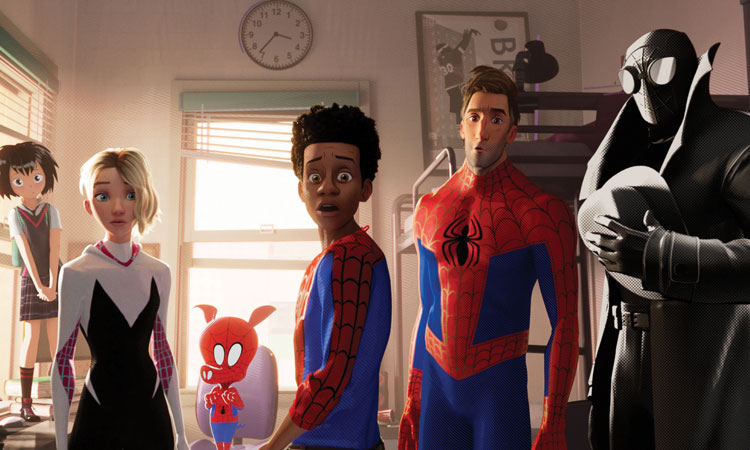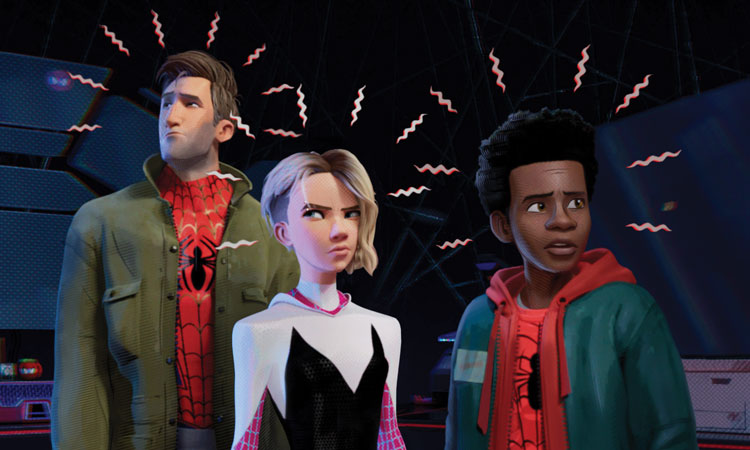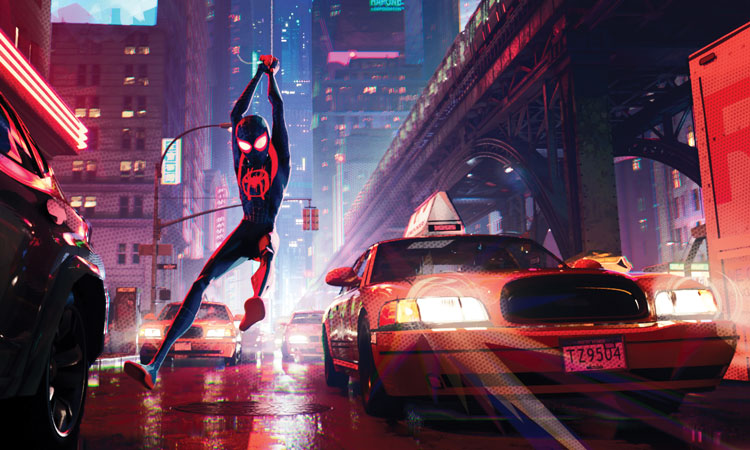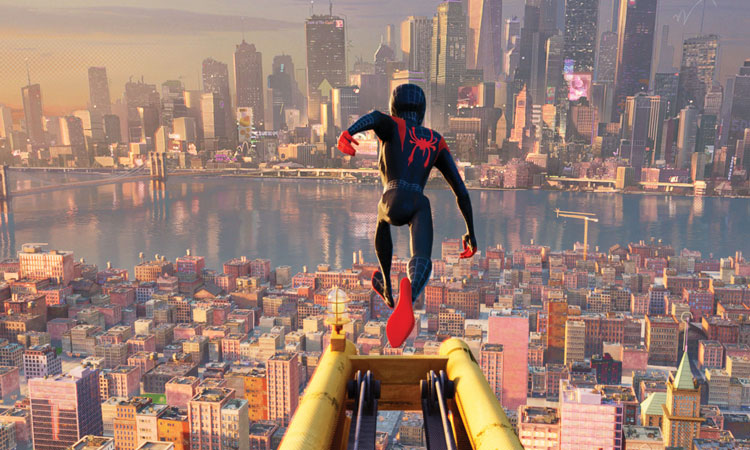It took Peter Parker 40 years to make it to the big screen. Miles Morales has done it in just seven. He’s yet to take a live action bow – although his Uncle Aaron appeared in Spider-Man: Homecoming, played by Donald Glover – but Spider-Man: Into The Spider-Verse is his big-budget animated movie debut. Created by Brian Michael Bendis and Sara Pichelli, Miles began life as the Spider-Man of Marvel’s Ultimate universe. He was an immediate success, and was soon moved to Marvel’s main universe, and has already appeared in a couple of animated TV shows – Ultimate Spider-Man and Spider-Man. Shameik Moore, the actor who plays Miles in Into The Spider-Verse, was only 16 when Miles made his first comic book appearance, and he literally grew up with the character: “I don’t even know how young I was when I first saw him,” Moore muses, but it had to be between 16 and 21 – the age at which he was first approached about playing Miles back in 2016.
But development on the film had started even before then – the Sony email hack of 2014 revealed that they were already in talks with The LEGO Movie directors Phil Lord and Christopher Miller about an animated Spider-Man movie. They ended up producing the movie – and Lord wrote the script – while directing reins were handed to three people – Rise Of The Guardians director Peter Ramsey, animator Bob Persichetti, who was head of story on Puss In Boots, and 22 Jump Street writer Rodney Rothman.
However, the film nearly didn’t happen at all, for one big reason: Do we really need another Spider-Man movie? Lord and Miller initially turned Sony’s offer down on those grounds, “but the offer stayed with them,” Rothman tells us. “They’re both fans of comics and various things in this area, and it was Phil and Chris who went back and said ‘we could be interested but it would have to be about Miles’.” The whole way through the process of making the movie, everyone was very aware of Spidey overkill – we’ve already had three different big-screen Spider-Men since 2002 – but Rothman tells us “we basically embraced that question and said: ‘Okay, every choice we make will answer that question. Whether it’s the character it’s about, whether it’s the look of the film, whether it’s the tone of the film,’ every step of the way we tried to challenge ourselves, to stretch and to go for something that would ideally be a new experience for an audience.”
This Spider-Man offers not only one new Spider-Man, but a veritable multiverse of them. “Miles is an African American Puerto Rican kid who lives in Brooklyn,” director Peter Ramsey says, “he’s a teenager, a very young teenager, 13, 14, and the film tells the story of how he gains the powers of Spider-Man in a world where Spider-Man already exists, so he’s got a legacy to live up to. He also ends up meeting a variety of other characters who are like him. So it’s the story of a teenager coming-of-age and discovering their place in the universe.”

In a nutshell, the plot sees the machinations of the evil Kingpin (Liev Schreiber) leading to a portal being opened between parallel dimensions, allowing various Spider-Men and -Women to spill over into Miles’ world. As the trailer shows, that ranges from the outlandish (Spider-Ham, a talking pig) to other break-out new characters, like Spider-Gwen, created in 2014, who comes from a dimension where Gwen Stacy, rather than Peter Parker, got bitten by the famous radioactive spider. Oh, and Nicolas Cage voices a version of Spider-Man from a Thirties noir dimension, naturally.
“I think we mostly chose [these Spider-Verse characters] because they were really different from Miles,” Ramsey says, “like Spider-Ham could not be more ridiculous or absurd in Miles’ world, and then we’ve got somebody like Spider-Gwen, who in our movie is very close in age to Miles, but she’s got a couple of years of experience on him. In a way she’s the most adept Spider-person in the movie, but she’s close enough in age to Miles that it felt like they could really bond over the shared experience.”
There’s one other Spider-Man in the movie that will be significantly more recognisable to audiences – by name, at least. Spider-Verse boasts a version of Peter Parker unlike anything we’ve seen before. “[The parallel dimensions] gives us license to create a version of Peter Parker that isn’t one that a movie would probably get behind as their hero, which is essentially Peter Parker at 40,” Rothman explains. “Peter Parker 20-plus years into the job, a grown up, with grown up problems. Maybe teenage Peter Parker has relationship problems or school or job problems, but grown up Peter Parker has marriage problems and has dad body problems, has metabolism problems, and he has existential problems related to just doing the job of a superhero for 20 years or being Spider-Man for 20 years, so, yeah, that was such a cool opportunity. And funny, you know? Peter Parker’s funny, so it was interesting to imagine who he would be. And to cast somebody, Jake Johnson, a really funny, smart, witty person who, I’m going to step out on a limb and say probably wouldn’t be cast as Peter Parker if he was 16, but really embodies what he might become.” While Peter Parker might be the bigger name, the directors always had it in mind that Miles was the real heart of the film. “[W]e wanted to find a portrayal of Peter that would really contrast with Miles and illuminate the struggles that Miles was going through in a way that made you think about the larger idea of Spider-Man and this whole idea of great power and great responsibility,” Ramsey says.

The film boasts a stellar voice cast (including two Oscar winners, no less), but finding the right person to play Miles was key, and led to an open, but very secretive, casting call in which hundreds of actors were considered, before the directors settled on Shameik Moore, who had been their first choice right from the beginning.
Moore “auditioned over the phone. He sent me a text with a bunch of audio files on it,” Bob Persichetti explained. But after getting the part, Moore got nervous. “I got in there in person after I got [the role] and I’m nervous so I’m in there and I’m like ‘I’ve got to be young-sounding!’ Miles is 13, 14 in this movie. Then Bob was like ‘Shameik, we like your voice, that’s why you’re here, we like your voice and let’s stay true to that. So I take his advice, and I just start making those parallels in my mind like how do I relate to Miles, and it wasn’t overnight, we did scene by scene, we were working for almost two years, and some scenes we did a few times. My main thing was being as believable and as heartfelt as possible… The animation was already going to be dope, I know that is out of my hands, but when you’re listening to what’s going on, I want you to sit there and be like ‘is this real?’ I want to feel believable, as if I am in a live action movie.”
Moore was absolutely determined to get the role (“he already thought he was Miles,” Persichetti jokes), and can’t help but see similarities between his own experiences and those of Miles: “I’m just thankful that I got chosen in the way Miles got bitten. I’m sure there are hundreds, probably a thousand, or more, people who auditioned for this movie to be Miles, so I was chosen the way he was chosen and I draw parallels, you know. I’m grateful.”
Voicing an animated movie can be a tricky and often isolated experience, with actors rarely recording their dialogue together. But Persichetti tells us that in order to get the energy they wanted into the film, they would need to shake things up a bit. “[O]ne of the things we were trying to do on this was just to create these performances that felt natural, where the script was a guide and less of a mandate, and so one of the best records we had early on was, you know, Shameik lives in Atlanta and Brian [Tyree Henry, who plays Miles’ father Jefferson] was shooting some episodes of Atlanta and so we flew to Atlanta and recorded them together. “It was the first time we had put them together and it turned into the car ride scene (seen in the trailer), and it was in that moment, sitting in the room, I was like ‘okay, this father-son dynamic is totally going to work, it’s great’.”
Moore also recorded scenes with Jake Johnson in order to capture the Peter Parker/Miles Morales banter that the film needed. “We record our actors before we animate because the animators are really depending on [their] vocal performance to create a performance on screen,” Persichetti says, “and that was what was so exciting about the way Shameik was delivering his lines and building a performance and evolving his character because, as he said, we recorded multiple times over two years and Miles grew over those two years, he evolved as a character while we were making the movie and we started to really cement ideas that became sort of the touchstones for him as a character and our animators found really interesting and I think were able to create unique performances because of his performance.”
During our conversations with the directors and Moore, they all frequently referred to the visual style of the movie. Part of what made Lord and Miller want to produce the movie in the first place was the potential for ground-breaking visuals. “Phil and Chris always look for opportunities to do something unexpected and/or different,” Rothman says, “and I think they saw an opportunity to test out some innovative ideas they had about what animation could be on a big stage. That was the genesis of all this about two or three years ago, and then gradually we all came in and started to work on how that would actually be pulled off.”

Ahead of our interviews, we were shown the first 35 minutes of the film and we can confirm that the creative team did indeed pull it off. If you’ve seen the trailer you’ll know that the animation style makes some very heavy visual nods towards comics – but you ain’t seen nothing yet. Just wait until the film hits top speed and you realise you’re watching a comic book come to life. “[Y]ou can pause on any frame of this movie and it’s a painting, or it’s a comic book page, every single one, bar none,” Ramsey says. “[E]veryone who worked on this movie is an artist in their own right.” Hitting upon the look of the movie “took us a year and a half to define our aesthetic,” Ramsey adds. “And the technical problem of how we were going to achieve it was even bigger.”
So big, in fact, that “we had no idea technically of how we were going to be able to do this,” Ramsey admits. “The guys at Sony Imageworks, who do all the technical and front- and back-end work on the movie, wrote tonnes of new code, developed new software, new AI programmes to do things like add the black ink expression lines on our characters’ faces, which is kind of a new innovation. The use of half-tone dots to express light and shadow and colour. All these things that we kind of ported over from the printing techniques that go into comics, we sort of poached from that to create the cinematic equivalent of comics.”
But fancy visual quirks wasn’t the only thing the creative team were leaning into – they wanted to make sure the worlds they were depicting felt as real as possible – albeit seen through the lens of a comic book. “[W]e went to New York, we did a lot of scouting for an animated film, which is kind of a little bit rare,” Persichetti says, “but we thought this movie has to feel incredibly subjective to a teenager that is growing up in Brooklyn. What would a teenager growing up today in Brooklyn be experiencing? We were inspired by what you can do in a comic book, because there’s freedom, freedom of creating a visual that’s really supportive of a world and a character, and that’s how we approached the film for Miles and Brooklyn and New York and all of those things. And then it was like, okay, if we’re going to bring these other characters in, then let’s say that there is a strong visual signature to their individual universes, and they’re going to bring it to this movie, and that’s how we’ll represent the diversity of the Spider-Men and -Women out there.” We’ve already glimpsed some of that in the trailer, with the animation styles for Spider-Ham and Peni Parker differing wildly from those used for Miles and Peter.
Even without all the new developments in animation technology, Spider-Man: Into The Spider-Verse would still be something pretty new – the comic book movie boom hasn’t really produced any big animated movies yet, bar some straight-to-DVD ones and this year’s Teen Titans GO To The Movies – plus of course The Incredibles, although that isn’t based on a comic. “I can only imagine that it’s partly because of the same sort of lag that it took for the characters to make the move to live action,” Ramsey muses. “It’s unusual that we didn’t get animated features before live action features became popular. It’s kind of interesting. One of the things that really informed what we wanted to do with this movie was the fact that there hadn’t been one, but at the same time there have been so many superhero movies. And we have been in sort of a golden age of big budget CG animation with movies like The Incredibles.”
Despite being an essentially new approach, Into The Spider-Verse runs the risk of feeling like it’s old hat just because of the proliferation of superhero movies and CG animated movies. “We’ve got to find new ways in our approach to really make this feel like something different,” Ramsey says, “to just wave our arms and say ‘hey, we’re here, we’re here!’ because there have been so many really well done versions of this character on the big screen.”
Spider-Man: Into The Spider-Verse is released in available on Netflix now.
